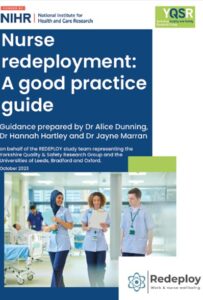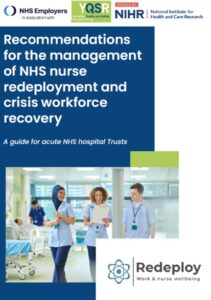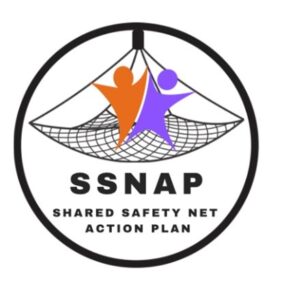Research Translation
Patient Reporting and Action for a Safe Environment (PRASE)
We developed and trialled the ‘Patient Reporting and Action for a Safe Environment’ (PRASE) intervention. Click here for more details on the trial. The Yorkshire Quality and Safety Research Group and the Improvement Academy are conducting further work to explore how PRASE feedback can be collected on a regular basis, and how hospital teams can access and use the intervention. More information about these next steps for PRASE can be found here, and a full list of PRASE related publications can be found here.
Central to the intervention are two tools for obtaining feedback from patients on the safety and quality of their care whilst in acute hospital settings. These are:
- The Patient Measure of Safety (PMOS) – a 44 item questionnaire designed to gain the patient perspective on their care, based on the content of the Yorkshire Contributory Factors Framework (YCFF). We have recently produced shortened versions of the questionnaire: PMOS-30 (30 items) and PMOS-10 (10 items). Work is currently underway to validate the shortened questionnaires.
- The Patient Incident Reporting Tool (PIRT) – a simple reporting proforma designed to be used in conjunction with PMOS, which allows patients to report detailed safety concerns and/or positive experiences.
Supporting references for these tools:
PMOS
Louch G, Reynolds C, Moore S, Marsh C, Heyhoe J, Albutt A, et al. Validation of revised patient measures of safety: PMOS-30 and PMOS-10. BMJ open. 2019;9(11):e031355
McEachan, R. R., Lawton, R. J., O’Hara, J. K., Armitage, G., Giles, S., Parveen, S., Watt, I. S., & Wright, J. (2013). Developing a reliable and valid patient measure of safety in hospitals (PMOS): a validation study. BMJ quality & safety, bmjqs-2013.
Giles, S. J., Lawton, R. J., Din, I., & McEachan, R. R. (2013). Developing a patient measure of safety (PMOS). BMJ quality & safety, 22(7), 554-562.
PIRT
O’Hara, J. K., Lawton, R. J., Armitage, G., Sheard, L., Marsh, C., Cocks, K., … & Wright, J. (2016). The patient reporting and action for a safe environment (PRASE) intervention: a feasibility study. BMC health services research, 16(1), 676.
O’Hara, J.K., Armitage, G., Reynolds, C., Coulson, C., Thorp, L., Din, I., Watt, I., & Wright, J. (2016). How might health services capture patient-reported safety concerns in a hospital setting? An exploratory pilot study of three mechanisms. BMJ quality & safety. Advance online publication. 10.1136/bmjqs-2015-004260
To request the tools or for more information please contact claire.marsh@yhia.nhs.uk
Achieving Behaviour Change for patient safety (ABC)
With funding from the Health Innovation and Education Cluster (HIEC, 2012-2014) we developed and evaluated a method for supporting UK Hospital Trusts to implement national patient safety alerts. We applied the Theoretical Domains Framework of Behaviour change and worked with hospital teams to identify barriers to change and feasible strategies to encourage change in practice. This approach is reported in two publications.
- Taylor N, Lawton R, Moore S, et al. Collaborating with front-line healthcare professionals: the clinical and cost effectiveness of a theory based approach to the implementation of a national guideline. BMC Health Serv Res. 2014;14:648
- Taylor N, Lawton R, Slater B, Foy R. The demonstration of a theory-based approach to the design of localized patient safety interventions. Implement Sci. 2013;8:123
Since 2013 we have delivered 18 Achieving Behaviour Change (ABC) for patient safety workshops at regional and national level to support teams in adopting this approach in their own organisations. A toolkit of resources and further information are available here.
Learning from Patient Safety Incidents (YCFF)
The Yorkshire Contributory Factors Framework (YCFF) was developed from a systematic review of 85 empirical studies that reported on the factors contributing to patient safety incidents in an acute hospital setting. In addition to the framework which provides a way of thinking about the factors that contribute to patient safety incidents, we have also developed a check-list which is used by risk managers and clinicians to learn from patient safety incidents. These tools might also be used by researchers and by those designing incident reporting systems.
For further information about the YCFF and associated tools please click here.
Supporting Involvement during Patient Safety Incident Investigations (Learn Together)
Using an independent research programme and a co-design process involving a community of stakeholders including patients and their families, patient safety managers, people who investigate, healthcare staff, legal representatives, and policy makers, we developed guides for:
- Patients and Families involved in a Serious Incident Investigation
- Engagement Leads carrying out these investigations for NHS Trusts
For further information about the Learn Together Programme and to download the guides please click here.
A visual story of incivility in hospitals
This comic story shares the findings from looking at evidence across the globe in a systematic way. We wanted to understand how hospital workers from racially minoritised backgrounds think and feel about the subtleties of workplace rudeness. We were keen to know what happens and how it affects them. Incivilities, those subtle yet potent actions that shatter mutual respect are the main focus. Within hospitals, incivility can silently erode individual well-being, how the team and hospital works, as well as how patients are taken care of. Evidence shows racially minoritised hospital workers are treated unfairly through bullying and discrimination, however the evidence of incivility is not well understood. Our goal is to shed light on these behaviours and their effects that people might not always notice, and to make everyone think about how their own actions can make things better for everyone at work.
Please enter your details to access the resource.
Redeployment of nurses in hospitals (REDEPLOY)

With funding from the National Institute of Health Research (NIHR) we have developed two resources:
- National recommendations for the management of NHS nurse redeployment and crisis workforce recovery: A guide for acute NHS Trusts
- A best practice guide to support those tasked with implementing nurse redeployment


For more information and to download these resources click here
Shared Safety Net Action Plan (SSNAP)

With funding from the National Institute for Health Research (NIHR) researchers based in the Yorkshire Quality and Safety Research Group (YQSR) have worked closely with patients, clinicians and staff in general practices to develop the Shared Safety Net Action Plan (SSNAP). This intervention is designed to reduce delays in cancer diagnosis by providing a safety net for patients who present with unclear or ambiguous symptoms. SSNAP is a personalised action plan that informs patients of the symptoms they have been asked to monitor, what exactly to look out for and a timescale to return to their GP.
Click here to watch a video that describes what SSNAP is and how it works in practice
What is safety netting and why is it important?
Patients sometimes visit their GP practice with vague and ambiguous symptoms and there can be uncertainty about the causes of symptoms and the diagnosis. In these situations, patients might be asked to monitor these symptoms and return if necessary. This is usually called safety netting. However, patients are not always sure about what symptoms to keep track of, for how long and when it is appropriate to book a return appointment. This can lead to delays in diagnosis. Patients can play a key role in achieving a more timely and accurate diagnosis by effectively monitoring their symptoms and booking a return appointment if necessary.
What did we do?
We spoke to and worked closely with patients, GPs and other clinical and non-clinical staff working in GP practices to help develop an intervention to improve timely diagnosis. This intervention helps GPs to work with patients who present with vague or ambiguous symptoms to monitor their symptoms and return if necessary. It supports patients to monitor their own symptoms and to know whether it is appropriate for them to return to the GP. We also applied psychological theory (COM-B) to strengthen the intervention development.
What did we find?
We found that patients wanted visual and written information that was personalised to them and summarised what symptoms they should be monitoring, what to look out for, and when to return. Clinicians and other staff working in GP practices agreed that this approach could empower patients to monitor their symptoms and may support health anxieties. They also told us that having SSNAP embedded in online systems (such as SystmOne or EMIS) so it links with the patient record, would make it more useful. The SSNAP intervention has since been adapted for use on SystmOne and can also be provided in a paper version, depending on patient preference.
What next?
We plan to test and refine SSNAP in practice through future research. If you are interested in using SSNAP, hearing about or getting involved in future research with SSNAP please contact Hannah Hartley on Hannah.Hartley@bthft.nhs.uk
Related publications
The Patient Wellness Questionnaire - supporting the implementation of Martha's rule
Since 2017, the YQSR team have been undertaking research investigating patient and family involvement in detecting and escalating deterioration in hospital, culminating in the following publications.
Albutt, A. K., O’Hara, J. K., Conner, M. T., Fletcher, S. J., & Lawton, R. J. (2017). Is there a role for patients and their relatives in escalating clinical deterioration in hospital? A systematic review. Health Expectations, 20(5), 818-825.
Albutt, A., O’Hara, J., Conner, M., & Lawton, R. (2020). Involving patients in recognising clinical deterioration in hospital using the Patient Wellness Questionnaire: A mixed-methods study. Journal of Research in Nursing, 25(1), 68-86.
Albutt, A., O’Hara, J., Conner, M., & Lawton, R. (2021). Can routinely collected, patient-reported wellness predict National Early Warning Scores? A multilevel modeling approach. Journal of Patient Safety, 17(8), 548.
Based on this work, the team have developed and evaluated a simple patient wellness questionnaire that allows patients or their relatives to provide information about their condition as a routine part of their care. Here we provide guidance on how to implement this as part of Martha’s rule.
Please click here to view the patient wellness questionnaire.
